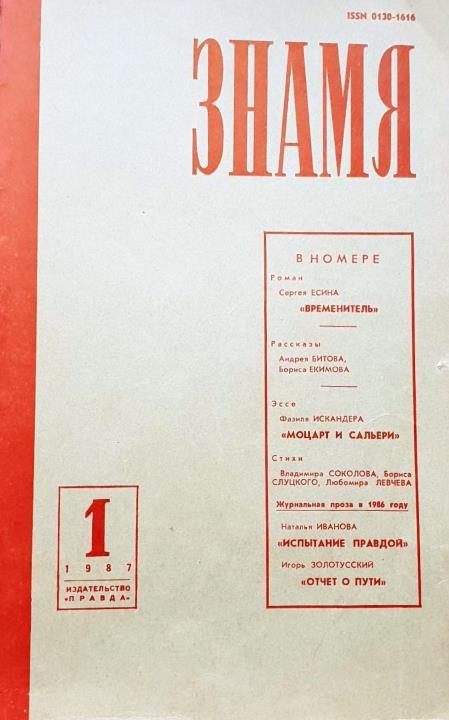Фотография Пушкин (1799–2099)
- by Андре́й Би́тов
- Novelette
- Science Fiction, Comedy
- Adults
- Definite Time Travel
- Russian
- “Фотография Пушкин (1799–2099)” [Pushkin’s Photograph (1799–2099)] by Андре́й Би́тов, Znamia, January 1987.
In 1985, an author has visions of a time traveler named Igor from 2099. The traveler is being sent by his comrades in the domed city of St. Petersburg back to the 19th century, where he is tasked with capturing images and audio of motherland’s supreme father of poetry, Alexander Sergeyevich Pushkin.
Note: A dissertation by Gulius Natalya Sergeevna notes that this story is part of Bitov’s Teacher of Symmetry Cycle, which consisted of a series of avant-garde stories purportedly written by an obscure Englishman named A. Tired-Boffin and loosely translated to Russian by Bitov. The English version of “Fotografiya Pushkin (1799–2099)” was said to have been called “Shakespeare’s Photograph” (or possibly “Stern’s Laughter” or “Swift’s Pill”), and presumably it was about Shakespeare rather than Pushkin.
Sergeevna explains that all this artistic mystification was part of an extensive footnote to “Fotografiya Pushkin (1799–2099),” but up in the ITTDB Citadel, we’ve yet to track down the footnote. Perhaps it was part of the 1987 publication in Znamia, or maybe it did not appear until the story was published along with the rest of the cycle in Bitov’s 1988 collection, Chelovek v peyzazhe. It is not listed in the table of contents of "]Prepodavatelʹ simmetrii(2008), which was translated to English as Symmetry Teacher (2014).
Note: A dissertation by Gulius Natalya Sergeevna notes that this story is part of Bitov’s Teacher of Symmetry Cycle, which consisted of a series of avant-garde stories purportedly written by an obscure Englishman named A. Tired-Boffin and loosely translated to Russian by Bitov. The English version of “Fotografiya Pushkin (1799–2099)” was said to have been called “Shakespeare’s Photograph” (or possibly “Stern’s Laughter” or “Swift’s Pill”), and presumably it was about Shakespeare rather than Pushkin.
Sergeevna explains that all this artistic mystification was part of an extensive footnote to “Fotografiya Pushkin (1799–2099),” but up in the ITTDB Citadel, we’ve yet to track down the footnote. Perhaps it was part of the 1987 publication in Znamia, or maybe it did not appear until the story was published along with the rest of the cycle in Bitov’s 1988 collection, Chelovek v peyzazhe. It is not listed in the table of contents of "]Prepodavatelʹ simmetrii(2008), which was translated to English as Symmetry Teacher (2014).
—Michael Main
. . . мы сможем в будущем, и не таком, господа-товарищи, далеком, заснять всю жизнь Пушкина скрытой камерой, записать его гол . . . представляете, какое это будет счастье, когда каждый школьник сможет услышать, как Пушкин читает собственные стихи!

translate
. . . we will be able in the future, and, gentlemen-comrades, not such a distant one, to photograph Pushkin’s entire life with a hidden camera, record his voice . . . imagine how wonderful it will be when every schoolboy will be able to hear Pushkin read his own poetry!
Tags
(20)
- Time Periods
- Circa AD 1800 to 1899: Pushkin’s time
- Circa AD 1970 to 1999: The author views the events from 1985
- Circa AD 2000 to 2099: Igor and his comrades are in 2099.
- Timeline Models
- Single Consistent Timeline: The story has only a single timeline, and there are some hints that it is static. Moreover, Igor can see only things that were known in his time.
- Viewing the Future: From his attic, Bitov sees and writes of the time traveler.
- Viewing the Past: From his attic, Bitov sees and writes of the time traveler.
- Time Travel Methods
- Luggable Time Machine: Igor seems to lug the necessary equipment around in a suitcase.
- Themes
- Ex Nihilo Obects and People: The 1833 coin that Igor receives from Pushkin might have been returned to Pushkin in 1824, so it could be a minor ex nihilo object.
- Save the Bigwig (excluding JFK and Lincoln)!: Igor tries to stop Pushkin from dying from wounds acquired in his famous duel.
- Time Montages: As Igor travels, he sees a sequence of times playing out in reverse.
- What Year Is It?: Igor asks the clichéd question.
- Real-World Tags
- Fictional Tags
- Groupings
Variants
(2)
- “Фотография Пушкин (1799–2099)” [Pushkin’s Photograph (1799–2099)] by Андре́й Би́тов, Znamia, January 1987.
- “Pushkin’s Photograph (1799–2099),” as by Andrei Bitov, in The New Soviet Fiction: Sixteen Short Stories, edited by Sergei Zalygin (Abbeville Press, 1989).. . . . . . . . . . . . . . . . . . . . . . . . . . . . . . . written by Андре́й Би́тов as by Andrei Bitov
Indexer Notes
(4)
- Debut—The [/d]January 1987[/d] debut citation comes from Fantlab and is verified by Footnote #25 in The Distorted Images and Realities of Andr ted Images and Realities of Andrei Bitov’s Liter s Literary
Photographs by José Vergara. We don’t know whether the debut or any later variants were explicitly credit to the hoax name A. Tired Boffin. - Length—The Russian original is about 13,400 words. The 1989 English translation is considerably longer, possibly as much as 20,000 words.
- Series Order—We use a Fantlab listing as the starting point for defining Bitov’s Teacher of Symmetry Cycle. It lists this novelette as the earliest and the novella “'Prepodavatelʹ simmetrii” as the second.
- Other Related Works—The main character, Igor, is a distant descendant of characters in Bitov’s earlier novel Pushkin’s house, which takes place in the historic St Petersburg Pushkin House. A later book by Bitov—also called Фотография Пушкин (1799–2099)—is a biography.
